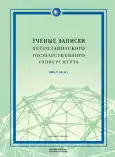THE CONCEPTUAL SPHERE OF HOMO CORPORIS: THE SOMATISM HAND IN RUSSIAN SPIRITUAL VERSES
- 作者: Mukhina E.A.1
-
隶属关系:
- Petrozavodsk State University
- 期: 卷 46, 编号 1 (2024)
- 页面: 20-25
- 栏目: Articles
- URL: https://journal-vniispk.ru/2542-1077/article/view/293250
- DOI: https://doi.org/10.15393/uchz.art.2024.986
- ID: 293250
如何引用文章
全文:
详细
The awareness of human corporeality determines human behavior and affects the spiritual guidelines ofsociety and culture as a whole. However, the concept of the corporeal human being, Homo Corporis, has not beensufficiently studied by the humanities. The cognition of the human body, its comprehension, and somatic perceptions ofpeople of different epochs are manifested in the language and reflected in mythology, philosophy, and art. The relevanceof the research is determined by the need to study the folklore picture of the world presented in spiritual verses andreflecting the general linguistic picture of the world through the prism of its perception by people. The human soul withits thoughts and desires is the main object of the evaluation of spiritual verse, a genre aimed at disclosing the image ofthe “inner person”. However, this does not exclude references to human physicality in the texts and the use of lexemesdenoting the “external person”. The article is aimed at identifying the specific genre characteristics of somatic vocabularywith the component hand in spiritual verses. The study was based on the texts collected in the XX century in Kareliaand adjacent territories. The article establishes the main meanings and concepts of somatisms included in the “upperlimbs” group, as well as the connection between their use and the specific features of the genre of oral folk art. Thestudy was conducted by the continuous sampling method, the holistic, structural-semantic, and cognitive analysis of theverses, and the quantitative analysis in order to determine the frequency of the use of somatisms. The author concludesthat the use of somatic vocabulary with the concept hand is determined by generally accepted cultural interpretations,but the lexical environment of somatisms emphasizes their close connection with the “inner person”. It is also worth noting the presence of purely Christian meanings, according to which the hand acts as a symbol of sacrifice, protection, and repose stressing the strength of a believer.
作者简介
E. Mukhina
Petrozavodsk State University
编辑信件的主要联系方式.
Email: kareliaptz@mail.ru
Cand. Sc. (Philology)
参考
- Golubtsova, N. V., Matveeva, O. N., Papsheva, G. O. “Homo Corporis” image: somatic vocabulary with the component “hand” in A. Akhmatova’s lyrics. Philology: Theory and Practice. 2020;13(6):37–42. doi: 10.30853/filnauki.2020.6.5. (In Russ.)
- Karateeva, E. O. Modal potential of proverbs and sayings containing somatic vocabulary. In: Language, culture, mentality: problems and prospects of philological research: Proceedings of the IV International Research Conference. Kursk, 2022. P. 107–113. (In Russ.)
- Nikitina, S. E. Man and society in folk confessional texts (the lexicographic aspect). Moscow, 2009. 353 p. (In Russ.)
- Podgornaya, V. V. Corporality in language. Philology: Theory and Practice. 2015;2(44-1):160–162. (In Russ.)
- Sinitsyna, N. V. The role of somatic vocabulary in shaping a picture of the world. Almanac of Modern Science and Education. 2011;6(49):233–235. (In Russ.)
- Tokareva, I. I. Ethnolinguistics and ethnography of communication. (F. A. Litvin, Ed.). Minsk, 2003. 244 p. (In Russ.)
补充文件








